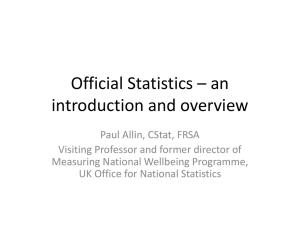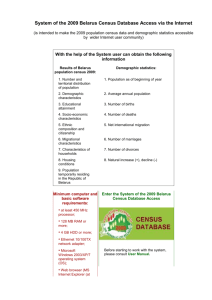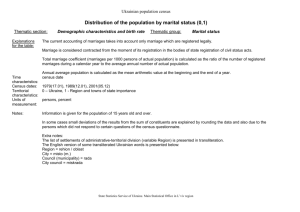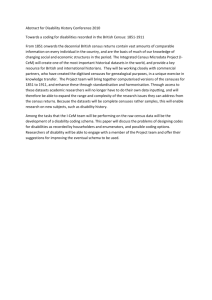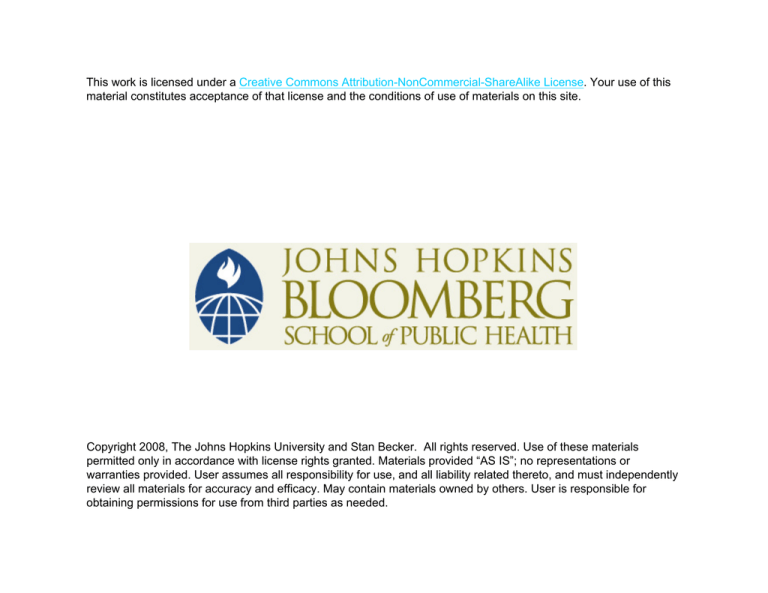
This work is licensed under a Creative Commons Attribution-NonCommercial-ShareAlike License. Your use of this
material constitutes acceptance of that license and the conditions of use of materials on this site.
Copyright 2008, The Johns Hopkins University and Stan Becker. All rights reserved. Use of these materials
permitted only in accordance with license rights granted. Materials provided “AS IS”; no representations or
warranties provided. User assumes all responsibility for use, and all liability related thereto, and must independently
review all materials for accuracy and efficacy. May contain materials owned by others. User is responsible for
obtaining permissions for use from third parties as needed.
Sources of Demographic Data
Stan Becker, PhD
Bloomberg School of Public Health
Section A
Civil Registration
Note
Note: Vital registration = civil registration
4
Demography
Demography—The study of a population in
its static and dynamic aspects
Continued
5
Demography
Static aspects include characteristics at a
point in time such as composition by:
– Age
– Sex
– Race
– Marital status
– Economic characteristics
Continued
6
Demography
Dynamic aspects are:
– Fertility
– Mortality
– Nuptiality
– Migration
– Growth
7
Demographic Analysis
Demographic Analysis—The study of
components of variation and change in
demographic variables and the
relationships between them
This is also called formal demography or
demographic methods
8
Population Studies
Population Studies—The study of the
relationships between demographic
variables and other variables such as social
and economic variables
9
Civil Registration
History
– Relatively modern concept in its present
format
– Churches have long maintained baptism
and burial registries
– Provided insight on the demographic
situation since the late Middle Ages
Continued
10
Civil Registration
Purpose
– Primarily administrative
– To collect data on the vital events
happening in a population (generally
concerned with live births, deaths,
marriages and divorces)
– Help understand demographic
characteristics of different populations
at different points in time
Continued
11
Civil Registration
Essential characteristics
– Universality
– Continuity
Definitions and content
– Live birth
– Death
– Marriage
– Divorce
12
Live Birth
Live birth—Complete expulsion or extraction from
its mother of a product of conception, irrespective
of the duration of pregnancy, which after such
separation, breathes or shows any other evidence
of life such as beating of the heart, pulsation of
the umbilical cord, or definite movement of
voluntary muscles, whether or not the umbilical
cord has been cut or the placenta is attached;
each product of such a birth is considered liveborn
Continued
13
Live Birth
All live-born infants should be registered
and counted as such irrespective of
gestational age or whether alive or dead at
time of registration, and if they die at any
time following birth they should also be
registered and counted as deaths
Source: WHO
14
Live Birth Registration
The United Nations recommends that the
following be collected at a minimum for live
birth registration:
– Data on event
• Date of occurrence
• Date of registration
• Place of occurrence
• Type of birth/delivery
• Attendance at birth
Continued
15
Live Birth Registration
Data on infant:
– Sex
– Legitimacy status
– Weight at birth
Continued
16
Live Birth Registration
Data on mother:
– Age or date of birth
– Number of previous children born alive
– Date of marriage or duration of
marriage
– Place of usual residence
17
18
19
20
Death Registration
Death—Permanent disappearance of all
evidence of life at any time after live birth
has taken place (post-natal cessation of
vital functions without capability of
resuscitation)
This definition excludes fetal deaths
Source: WHO
21
Fetal Death
Fetal Death—Death prior to the complete
expulsion or extraction from its mother of a
product of conception, irrespective of the
duration of pregnancy
The death is indicated by the fact that after
such separation the fetus does not breathe
or show any other evidence of life, such as
beating of the heart, pulsation of the
umbilical cord, or definite movement of
voluntary muscles
22
Fetal Death Categories
Three major categories of fetal deaths
recommended by WHO:
– Early fetal death: < 20 completed
weeks of gestation
– Intermediate fetal death: ≥ 20 but < 28
weeks
– Late fetal death: ≥ 28 weeks
23
Stillbirth
Stillbirth—Late fetal death
To be used only if essential for national
purposes
24
Death Registration
The United Nations recommends that the
following be collected at the minimum for
death registration
– Data on event:
• Date of occurrence
• Date of registration
• Place of occurrence
• Cause of death
• Certifier
Continued
25
Death Registration
Data on decedent:
– Age or date of birth
– Sex
– Marital status
– Occupation
– Place of usual residence
26
Problems with Cause of
Death Data
Knowledge of certifier
Certifier may never see deceased
“Garbage codes”: missing, senility, etc . . .
Heart versus brain function loss in the
definition of death
Continued
27
Problems with Cause of
Death Data
Multiple and contributory causes of death
Medical classification changes over time
– François de la Croix
– John Graunt
WHO and the International Classification of
Diseases (ICD); now at version 10
28
Classification of Cause of Death
from John Graunt in 1662
Bleeding
Burnt and scalded
Drowned
Excessive drinking
Frightened
Grief
Hanging
Killed by several
accidents
Murdered
Poisoned
Smothered
Shot
Starved
Vomiting
29
Death Registration
Note: causes of death can be regrouped in
smaller categories than in ICD
– e.g., Preston’s classification of causes of
death in 12 categories
30
Preston’s Classification of
Causes of Death
Respiratory
Other infections and
parasitic
Neoplasms
Cardiovascular
Influenza, pneumonia,
and bronchitis
Diarrhea, gastritis,
enteritis
Degenerative diseases
(ulcers of stomach,
diabetes)
Complications of
pregnancy
Diseases of infancy
Motor vehicle
accidents
Other accidents and
violence
Other
31
Marriage Registration
Marriage—Ceremony or process by which
the legal relationship of husband and wife
is constituted
The legality of the union may be
established by civil, religious, or other
means as recognized by the laws of each
country
Source: United Nations
Continued
32
Marriage Registration
The United Nations recommends that the
following be collected at a minimum for
marriage registration:
– Data on event
• Date of occurrence
• Date of registration
• Place of occurrence
• Type of marriage—civil, religious,
customary
Continued
33
Marriage Registration
Data on bride and groom
– Age or date of birth
– Previous marital status
– Place of usual residence
34
Divorce Registration
Divorce—Final legal dissolution of a
marriage, that is, that separation of
husband and wife which confers on the
parties the right to remarriage under civil,
religious and/or other provisions, according
to the laws of each country
Source: United Nations
Continued
35
Civil Registration
Evaluation of coverage and content
– Matching studies
– Aggregate demographic analysis
Cost
– High
36
Civil Registration
Notes:
– Adapted from UN Handbook of Vital
Stats Systems and Methods—Series F
No. 35
– Data available for the 1970s
Continued
37
Civil Registration
Notes:
– Figures in parenthesis are numbers of
countries or areas in each continent that
have sent vital statistics to the United
Nations
– Registration is said to be virtually
complete when at least 90 percent of
the events occurring each year are
recorded
Continued
38
Number of Countries with Virtually Complete Civil
Registration by Vital Event and by Continent
Vital Events
Continent
Total (165)
Africa (37)
America, North (35)
America, South (13)
Asia (23)
Europe-USSR (37)
Live
Births Deaths Marriages
91
85
87
7
27
4
7
36
6
26
4
6
34
4
32
2
7
36
39
Civil Registration
Advantages
– Continuous monitoring of vital rates
– May provide both numerator and
denominator for some rates (e.g.,
Infant Mortality Rate—IMR)
– Small area data available
– Base for testing the accuracy of
censuses and surveys
Continued
40
Civil Registration
Disadvantages
– Uncertain coverage: Difficult to ensure
registration of all the events
– Limited background information
– Time reference often inconsistent with
denominator definition
– Information may come from third party
Continued
41
Civil Registration
Disadvantages
– Easily disrupted by political/economic
events
– Literacy/numeracy
– Costly
42
Points to Watch in Data
Coverage (always evaluate for developing
countries)
Delayed registration
Classification done by place of residence or
place of occurrence?
Treatment of non-response
Other issues
43
Personal Identification
Number (PIN)
Method used in Israel, South Africa,
Sweden, and Thailand
Each individual is assigned a unique
number used for the rest of his/her life on
all pertinent documents in the national data
system
System acts as a census because it is
continuously updated by births, deaths,
immigrants, and emigrants
44
Summary
Demography is the study of a population in
its static and dynamic aspects
Civil registration is a system developed to
collect data on vital events (live births,
deaths, marriages and divorces) happening
to a population
Continued
45
Summary
Civil registration is continuous and
universal (it should give small area data)
The cost is high, but not having the
information may be more costly
There are advantages and disadvantages
to the system and its completeness varies
widely between countries and continents
Continued
46
Summary
The United Nations has recommended a
minimum list of information to collect on
each type of event
To that list, individual countries add data
that they believe is necessary for better
monitoring of their specific situation
47
Section B
Censuses
Censuses
Census—The total process of collecting,
compiling, analyzing, and publishing or
otherwise disseminating demographic,
economic, and social data pertaining to all
persons in a country or in a well-delineated
part of a country at a specified time
Source: United Nations
49
Essential Characteristics
Universality
Simultaneity
Individual enumeration
50
History
Egypt 3000 B.C.
– “Census” every other year
– List of families and other occupants of
houses for certain particular cases (e.g.,
soldiers)
Greece
– Count of males 18 years and older
Continued
51
History
Rome
– Enumeration of every family every five
years for taxation purposes
England 1066
– Domesday book
Continued
52
History
Modern census
– Format emerged gradually around
1600s in Europe
– Quebec 1666
– England 1841 (first real census)
– 1850 (first time to list individuals in
U.S.)
53
Content and Types
A census contains:
– Demographic data (at least age and
sex)
– Economic data (e.g., occupation and
income)
– Social (e.g., education and housing)
Continued
54
Content and Types
Example
– 1990 census content as regard to
population (adapted from U.S.
Department of Commerce, Census 1990
Basics)
Continued
55
Content and Types
100-percent component
– Household relationship
– Sex
– Race
– Age
– Marital status
– Hispanic origin
Continued
56
Content and Types
Sample component
Social characteristics
– Education (enrollment and attainment)
– Place of birth, citizenship, and year of
entry into the United States
Continued
57
Content and Types
Social characteristics
– Ancestry
– Language spoken at home
– Migration (residence in 1985)
– Disability
– Fertility
– Veteran status
Continued
58
Content and Types
Economic characteristics
– Labor force
– Occupation, industry, and class of
worker
– Place of work and journey to work
– Work experience in 1989
– Income in 1989
– Year last worked
Continued
59
Content and Types
A census can be conducted:
– De jure: Legal or customary attachment
to an area (you are registered where
you usually reside)
– De facto: Physical residence (you are
registered where you are currently
staying/residing at the time of the
census)
60
Data Collection Procedures
Establish administrative tree (census
officers, supervisors, enumerators)
Develop questionnaire(s)
Cartography
Define enumeration areas
Pretest enumeration processes
Design data processing system
Enumeration (postal with follow-up,
general canvas)
61
Evaluation
Estimation of undercounts
– e.g., U.S. 1940–1990
– Post-enumeration survey
– Demographic evaluation
62
Race
Net Population Undercount (In Millions)
In The U.S. Census By Demographic Analysis, 1940-1990
1940
1960
1980
1990
Total
Population
131.7
179.3
226.6
248.7
7.0
5.6
2.8
4.7
118.8
160.5
199.9
218.2
5.9
4.3
1.6
2.9
Population
12.9
18.9
26.7
30.5
Undercount Numbers
1.1
1.3
1.2
1.8
Undercount Numbers
Non-blacks
Population
Undercount Numbers
Blacks
63
Evaluation
Notes
Adapted from Edmonston, B., and Schultze, C.,
1995, “Modernizing the U.S. Census,” National
Academy of Sciences Press
Alaska and Hawaii became states in 1959
– For 1950 and earlier, the population data and
undercount estimates are for the 48
coterminous states
– For 1960 and after, the data includes Alaska
and Hawaii
64
Cost
Estimates
– $10 per head in the U.S.
– $1 per head in most developing
countries
65
Advantages
Universal, hence small area data available
National effort
Provides frame for later sample surveys
Provides population denominators
66
Disadvantages
Size limits content and quality control
efforts
Cost limits frequency
Delay between field work and results
Sometimes politicized
67
Imputation Technique
To assign values to “Unknowns”
– Cold deck: use the frequency
distribution of known cases
– Hot deck: take values from previous
case with same other characteristics
68
Points to Watch in Data
Population definition
Coverage change between censuses
Treatment of non-response
Imputation technique
69
Summary
Censuses are universal, simultaneous and
require individual enumeration
A census can be conducted de jure, de
facto or some combination
Preparing a census is a meticulous process
including many steps
Censuses should give small area data,
although coverage is not always certain
Continued
70
Summary
The cost is high, but not having the
information may be more costly
Censuses should be evaluated to estimate
the quality of the data; several techniques
exist for that purpose
There are advantages and disadvantages
to the system
71
Section C
Surveys
Surveys
Purpose
– Obtain information from a sample
representative of some population
Content
– Varies widely
– e.g., fertility, child mortality, migration
73
Essential Characteristics
Representative sample of some population
Smaller size than census allows collection
of more in-depth information that can then
be generalized
74
Types of Surveys
Single-round retrospective
– Census-type household surveys
– Focused, (e.g., Contraceptive
Prevalence Survey (CPS))
– Birth/Maternity history (World Fertility
Survey (WFS), Demographic and Health
Survey (DHS))
– Health monitoring
Continued
75
Types of Surveys
Summary of DHS
For more details, go to:
http://www.measuredhs.com/data/search_
surv_std.cfm?Action=region&CFID=32820
&CFTOKEN=34788473
Continued
76
Types of Surveys
Multi-round follow-up (prospective)
77
Sampling Methods
Sampling frame, generally from census
Separate strata are often defined for
sampling
– The provinces of a country could be
strata or urban and rural areas
– There may be multiple strata
Continued
78
Sampling Methods
Census enumeration areas or sections of
them may constitute a cluster from which
households are sampled (clusters are
typically sampled within strata and then
households within clusters)
Sample size may range from one to four
thousand women to hundreds of thousands
of people
Sampled clusters may range from 20 to
400 or more
79
Cost
In the 1990s, ranged approximately from
$10 to $150 per capita
Least expensive method
80
Advantages
Single-round retrospective
– Can be quick
– Relatively inexpensive
– Flexible
– Can include detailed data
– Needs little continuity effort
Continued
81
Advantages
Multi-round prospective
– Some control on coverage and content
errors
– Follow-up allows control for sampling
distortion
82
Disadvantages
Single-round retrospective
– Coverage and content errors
– Misses certain types of events
Multi-round prospective
– Slow
– Needs continuity of effort over
(extended) time
– High cost
83
Summary
Surveys are done to obtain information
from a sample representative of some
population
Surveys are of a smaller size than a
census, which allows for collection of more
in-depth information that can then be
generalized
There are many types of surveys
Continued
84
Summary
The sampling method used in surveys is
often multistage (e.g., household within
cluster, themselves taken within strata)
Surveys are less expensive than censuses
and civil registration (smaller size allows for
quick collection of more in-depth
information than any of the other two
systems)
They have advantages and disadvantages
85




